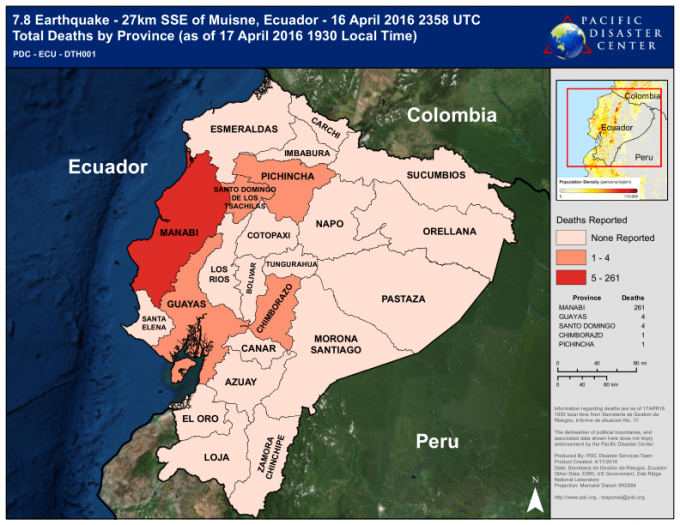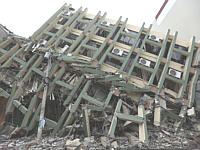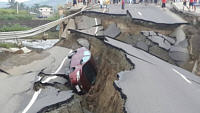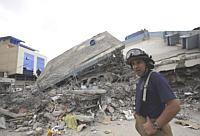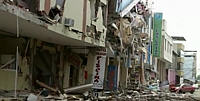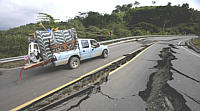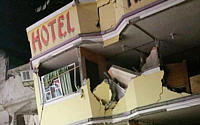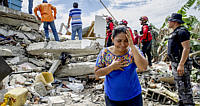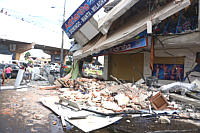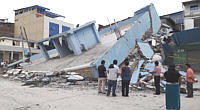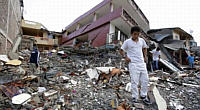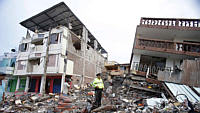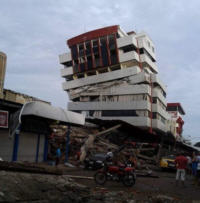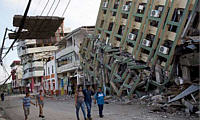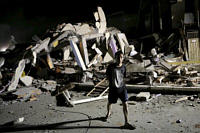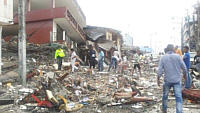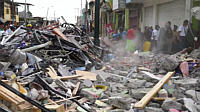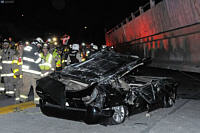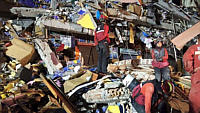
On Saturday, April 16, 2016, Ecuador experienced
a series of five earthquakes, the largest being a 7.8 magnitude on the northwest
coast of Ecuador near Pedernales. At the least,
nearly 300 people have died and
there's many millions of dollars in property damage. (These are just early estimates, since there are many towns that
are cut off from the outside world, so there is no way to access the true scale of the damage.)

Over the past two days, hundreds of people --- family, friends,
clients, vendors, etc. have called or written to us to ask how we are doing. People often want
"on the ground" inputs since the news media is so prolific at lying about details and
twisting the facts to suit their purposes.

The truth is that, yes, the major earthquake
was severe and damage in Esmeralda and Manabi provinces is quite extensive.
We know families that have been affected. As for the event itself, everybody here felt it in
Azuay and the other southern provinces, but there is no serious damage. Frankly, the strength
of the two major earthquakes (7.4 and 7.8M), which happened back-to-back, one after the other
from the same location in northwestern Ecuador, did not disturb us as did the duration.
Together they went on for about two minutes, and we wondered at one point when the shaking
was going to end. But end it did, and except for a few books that fell off the bookshelf and
hung pictures that needed to be re-positioned, the earthquake was uneventful.

We have read reports of "the" earthquake -- (remember,
there were five, not one) -- severely affecting seismic activity in the U.S. I find this a
dubious claim . . . as if the U.S. is being more heavily impacted by this quake, thousands of
miles away, than we are . . . just 200 miles from the epicenter. Time will tell if any of the
high drama playing out in the Western media is justified, but for now, know that we are well,
and there is no effect to our lab or general operation.

Thank you, all, for your genuine concern and well-wishes.

It is greatly appreciated.
 Update -- April 23, 2016:
Update -- April 23, 2016:

Many of our family, friends, and customers have asked for
for an update on what is going on here in Ecuador. Yesterday, we met with a manager of First Responders and
even WE were surprised to hear how much media reports differenced from what people "on the ground"
were actually experiencing -- or how the severity of the situation has been downplayed.
The
latest CNN report
is bad enough, but the reality is worse. Here are the highlights:
 1. Aftershocks Not Abatting.
1. Aftershocks Not Abatting. There have been over
800 aftershocks, several of them over 6.0 (major earthquakes in their own rights), the latest just
hitting yesterday.
The entire eastern edge of the Nasca plate is showing signs of instability. There was even a new M4.9
earthquake south of Guayaquil yesterday, over 150 miles south of the site of the original
M7.8 earthquake.
 2. Lack of Command and Control.
2. Lack of Command and Control. The federal government
here has done everything it can to save lives and preserve order. But no one was prepared
for a disaster of this magnitude. There are many distinct groups bringing in supplies but little
to no coordination between them. The government here brought in 80 body bags, but confirmed
dead is now approaching 1,000. You would think that with the number of severe earthquakes
hitting points on the Pacific's "Ring of Fire," there would be international organizations
created to provide hierarchical structures to prevent this kind of widespread chaos, but apparently,
no such structures exist. This has led to widespread waste of resources. Thousands of bottles
of purified water were brought in, only to have many of them sit on the beaches in 35 C (95 F)
temperatures, bursting before anyone could actually drink from them.
 3. Looting.
3. Looting. One convey of 10 trucks here was
escorted by a police vehicle, and as it approached Manta, it was overcome by a mob of thirty
men who didn't hesitate to attack the police vehicle first. In Pedernales, a group put out the
word that a tsunami was coming, and after people evaculated the town, those who left had their
homes robbed. We can't confirm that this was a coordinated effort, but many First Responders
believe that it was.
 4. Animal Response.
4. Animal Response. Dogs and other animals
can be seen running through the streets, carrying a human hand, part of a face, or other human
body part in their mouth. With nowhere else to get food, domesticated animals have taken to
feasting on the mass of human remains for which there is too great a number for Responders to
get to in a timely manner. Some of the mosquitoes in the area are an inch in length, and thousands
of people who have to sleep outside at night (because the danger of re-entering their homes is too
great) have to cover themselves with netting (if they are even able to obtain it) to prevent getting
overwhelmed by mosquitoes at night. Scorpions, snakes, and other verment are partaking of the
feast, as well, increasing their numbers as more of them make an appearance.
 5. Orphans.
5. Orphans. There are close to a hundred children
(and their number of growing) who have been identified as orphans. With their parents gone and
no one else to take care of them, relief efforts are being made to find them homes.
 6. Most of the Missing Will Be Confirmed Dead.
6. Most of the Missing Will Be Confirmed Dead.
It is now a week since the disaster struck, far past the 72 hour window past which only 3-5%
of those left in the rubble of the 10,000 levelled buildings can be expected to be alive.
In the end, the total confirmed dead could be 3,000 to 4,000, placing the loss of life on
the order of the 9/11 disaster.

Easily, this is the worst disaster in terms of effects
on human life, that we have seen in our nearly 10 years of living in South America.

If you like to assist to the coastal people of northwestern
Ecuador, one of the worst disasters in its history, please read the following statement by
our good friend, Mr.Robert Higgins:
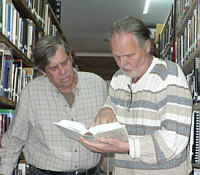
 23 Apr 2015 @ 2:45 Quito Time : 23 Apr 2015 @ 2:45 Quito Time :
"My name is Robert Higgins, and I am coordinating efforts with people that have boots on the ground
in the affected areas on the coast. First I would like to say that the damage and devastation is much
worse than the media is reporting. My contacts are reporting that, at this time, there are 1,500+ dead
and there are remote areas that help has not been able to get to yet. There is a major problem with looting,
theft and corruption. Please check carefully on who you send money to. I am currently helping coordinate
three initiatives. One is a government-sanctioned tent city with compost toilets and a food kitchen that
will serve 500 people. There will also be between 80 and 100 orphans that will be relocated to Cuenca within
the next few weeks. We will be working with a organization called Ecuador Cares (EcuadorCares.com) that works
to support the orphanages in the area to do what we can for these children who have endured so much.
Lastly, I am working with a team that is venturing into some of the more remote areas to help people who
have not been reached yet by the official organizations. We are collecting money for these projects through
Paypal at RHSpeaker. My email is RHSpeaker@gmail.com. 100% of the monies we receive go to these projects.
No overhead. No salaries. We are producing regular updates to let our contributors know where their money
is being spent and I have a team of expat and Ecuadorian advisors that I consult with to try to make each
dollar count. As far as a reference goes I can think of no better reference than Greg Caton . . . "
|
 Update -- April 26, 2016:
Update -- April 26, 2016:
 [Bob Higgins / Cuenca, Ecuador ] ---
[Bob Higgins / Cuenca, Ecuador ] --- " In the week that
I have been involved in the recovery effort on the
coast of Ecuador I have seen the best and the worst that humanity has to offer. It seems like the two forces
(best and worst) are pretty evenly matched. There are thousands of volunteers, fund raisers and "boots on the ground,"
including the Ecuadorian military and police who have been working tirelessly and putting themselves in harms way
(heat, mosquitoes, emotional distress, disease, smell of death, etc.) in order to try to save lives, bring relief
aid and comfort those who are affected by this tragic natural disaster.

These brave and giving individuals show us, with their compassion, efforts
and donations the potential we have as individuals to make a difference in the lives of our fellow human beings,
even at the risk of peril to themselves.

The other side of this story involves stealing, looting, attacking convoys,
raiding neighbors for their food and supplies, and an attitude of entitlement held by some that suggests that they have
no responsibility to help themselves with their own recovery. A friend of mine just returned from the coast and
tells these stories: They went into one area where there was a man in his pickup truck listening to music and when
he saw my friend he rolled down the window and yelled, "When are you going to bring me some food?"
While returning home from the coast one car full of volunteers was attacked while stopped at a red light
and thieves stole all their personal items. Many people are now leaving the coast and traveling inland by foot
and as they pass through towns they are raiding gardens and farms and stealing all they can. Areas that did not
require aid because of the earthquake are now in need because of theft and looting. People are stealing water
bottles from each other and selling them at $5.00 each and some unscrupulous people with generators were charging
up to $20.00 to charge a cell phone.

Don't get me wrong. I could site just as many stories of love, compassion and giving.
The point is that recovery is slowed down because of this conflict of "best and worse" and it is very important to know
where you are donating your money because even at the organizational level there is a lot of disorganization, wasted money
and pilfering of funds. Here are a list of organizations that I have thoroughly checked out and I believe are trustworthy
and are having a positive impact. All these organizations are in the Cuenca, Ecuador area: I have done extensive research
of each of these organizations and these are the ones that I use my fundraising dollars with:
- The Waterbearers (www.Waterbearers.org) have a water filtration system that is portable, easily installed and user friendly.
It can filter rainwater, river water, well water, etc and each unit ($50.00 ea) can supply 100 people with water for up to 10 years.
- The Cinterandes Foundation (Cinterandes.org) does many things, but they have been invaluable in this disaster because they
have a mobile surgical unit that has been in the heart of the disaster area from the beginning.
- The Hearts of Gold Foundation (HeartsofGold.org) has been a well established charitable organization here in Cuenca
for many years and has been working to send relief supplies and personal to the site since the beginning.

I believe that each of these organizations are registered, and donations can be written
off as charitable donations. I am collecting donations through The Cuenca Holistic Health Network (www.CuencaHolisticHelth.com)
and am dispersing funds to these and other trusted organizations as needed. You can contribute to this effort by Paypal at RHSpeaker.
I encourage you to ask questions and spread the word about the needs of these devastated communities by emailing me,
Robert Higgins, at
RHSpeaker@gmail.com. "
 Cathryn Caton, N.D.
Cathryn Caton, N.D.
Alpha Omega Labs
Cuenca, Ecuador
April 18, 23, 26, 2016
